Several hardware upgrades make the Surface Duo 2 far more compelling than its predecessor, but the software experience is still a big let-down.
Pros
- Much-improved performance
- Impressive displays
- Solid cameras
Cons
- Buggy software
- Most apps not optimised
- Slow charging
- Expensive
Our Verdict
Microsoft first revealed the Surface Duo back in October 2019, but it hasn’t been smooth sailing. The original model took almost a year to be released in the US, and several months longer elsewhere including the UK.
By the time it finally came to market, the first-gen device was almost destined to fail. Its outdated Snapdragon 855 processor came without 5G, while a 60Hz display and just one 11Mp camera didn’t win many suitors.
That’s before you consider chunky bezels and a questionable software experience, all at a price that made the device very unappealing. And that’s without even comparing it to rivals from Samsung and Huawei.
Microsoft has focused its attention on getting the hardware right this time around – the Surface Duo 2 is a huge upgrade over its original, and is already available in several countries around the world. But the software experience is what will ultimately determine the Duo 2’s fate and, well, it’s not good news.
Design & Build
- Two 5.8in displays, total screen area 8.3in
- New triple rear camera module
- Premium design and build
The Surface Duo 2 has the same basic form factor as its predecessor, consisting of two displays attached via a strong hinge. Near-identical dimensions disguise the fact that Microsoft has managed to increase the screen sizes here. I’ll talk about the quality of these screens in more detail in the next section.
It’s easy to understand how Microsoft has managed to increase the display size without significant changes to the total footprint of the device. The Duo 2’s bezels are noticeably smaller than the original, making it feel more premium and futuristic than before.
This feels impressively robust, reinforced by aluminium that extends down the back of the phone where the screens meet. At no point throughout my testing did it feel anything but strong and sturdy – that’s a testament to Microsoft’s engineering.
Having a 360-degree hinge you can rely on makes the Duo 2 impressively versatile. Microsoft officially advertises five key modes: regular Book (both in portrait and landscape), Compose (with the bottom screen used as an on-screen keyboard), Single screen and Tent (pictured below). Each has its own strengths and weaknesses, but it’s great to have so many potential use cases within one device.
Firstly, there’s no raise to wake functionality – you need to press the power button for it to show up. You’re also currently limited to incoming calls, messages, current volume and battery percentage. Support for app notifications would make it much more useful.
Aside from a slight wobble when face down on a table, I had no other problems with it – as you’ll see from the camera section, both these and the 12Mp selfie camera were worth including.
However, the latter doesn’t support face unlock of any description. It means you’ll have to rely on the fingerprint sensor built into the power button, but this was fast and responsive throughout my testing.
This rear camera module is the defining feature on the back of the device. In fact, the glossy Microsoft logo on the other screen is the only other element worth noting. It tends to pick up fingerprint smudges, but that’s less of an issue elsewhere on the glass exterior. I can only comment on the Glacier White model tested, though – there’s also a new Obsidian Black option.
However, even when closed, the Surface Duo 2 is still a bulky device. As well as being much wider and around twice as thick as regular smartphones, it weighs in at a hefty 284g – that’s up from 250g on the original Duo. You could argue that you’re getting two screens for that, but it’s undoubtedly less portable than almost every other smartphone. Storing the Duo 2 in your pocket is still possible, just much less comfortable.
Ports are also kept to a minimum – there’s a single USB-C port, plus space for just one SIM card. A 3.5mm headphone jack would have been nice, but it’s far from a priority these days. The device technically has waterproofing, but it’s the bare minimum IPX1 standard. This allows for vertically falling drops equivalent to 1mm rainfall for 10 minutes, so offers little protection.
You may also notice the stylus in many photos – that’s the Surface Slim Pen 2. It’s available as an optional extra, but compatible with all recent Surface devices. However, my review unit didn’t include a stylus, so I can’t comment on how effective it is.
Display
- 5.8in AMOLED displays
- 90Hz adaptive refresh rate
- Great viewing experience
The design elements mentioned above are all important, but they’re ultimately a supporting cast to the main event – the display. As the name suggests, the Surface Duo 2 has two of them, although both are now 5.8in instead of 5.6in on the original.
When fully open, that gives you a total screen area of 8.3in – the same as you’ll find on the latest iPad mini.
The latter is new to the Surface Duo, and it has the same effect as on a regular smartphone. Visuals are fluid and buttery-smooth, especially while scrolling social media or browsing the web.
This is an adaptive refresh rate, meaning it increases and decreases according to the situation. The most noticeable drop is when content is moving between the two displays, but it wasn’t too much of an issue.
Each screen has a 1344×1892 resolution and boxy 4:3 aspect ratio, making for a total display area of 1892×2688.
Both panels are crisp and detailed, equally capable of vivid colours and deep blacks. The Surface Duo 2 also gets impressively bright – I recorded a maximum brightness of 696 nits, meaning regular outdoor use shouldn’t be an issue.
For those occasions where you’d like to use just one screen, the Duo 2 will prioritise the right display. This feels the most natural, although double tapping on the left screen lets you switch.
Specs & Performance
- Snapdragon 888 processor (5G built-in)
- 8GB RAM
- Excellent performance
- Entry-level 128GB storage may not be enough
Some of the Surface Duo’s big problems were under the hood, but Microsoft has put that right with its successor. Qualcomm has released two flagship chips since the Snapdragon 888 that powers the Duo 2, but it still delivers the top-level performance you’d expect. It also has 5G built-in, something Microsoft wasn’t able to include on the original model.
Alongside the Adreno 660 GPU and 8GB of RAM across all configurations, performance is predictably very good. Basic use cases such as web browsing, instant messaging and social media aren’t a problem for the Duo 2, but it was the multitasking experience that particularly impressed me. Even demanding apps can run side-by-side without issue.
However, opening and closing apps can cause problems. That’s where I noticed hesitation and stuttering at times, while some apps crashed when trying to open them across both displays. But it didn’t feel hardware-related, just a case of software that’s not optimised to run on dual-screen devices. I discuss this in more detail in the following section.
Overall, the Surface Duo 2 delivers impressive performance in almost all areas. That’s reflected in the benchmarks below, which put it roughly in line with the best foldable phones available right now:
However, using the cheapest model I tested may cause issues with regard to internal storage. It offers just 128GB, with no option to expand with a microSD card. If you think that might be a problem, you’ll need to pay extra for 256- or even 512GB.
It’s also worth highlighting the presence of NFC here, something which was missing from the original Duo. For most people, its main purpose will be contactless payments using Google Pay.
Given the need for large bezels, there’s space for dual stereo speakers, in addition to the earpiece. This makes for a great audio experience that’s far superior to what you’ll find on most smartphones, offering a rich sound with a decent amount of bass.
It also means the calling experience is impressive, even if you probably won’t be holding the Duo 2 up to your ear. Dual mics mean the person on the other end can hear you loud and clear, too.
Software & Apps
- Microsoft’s skin over Android 11
- No word on upgrade to Android 12 (or Android 12L)
- Software very buggy, many apps not optimised for dual screens
The Duo 2 is the only Surface device that doesn’t run Windows, with Microsoft opting for Android instead. This makes sense, given it’s designed to replace your smartphone and Windows Phone is a thing of the past. However, the Surface Duo 2 is still running Android 11 at the time of writing, with no word on when it’ll get the update to Android 12.
It’s taken 16 months after release for the original Duo to get Android 11, so we may still be waiting a while.
As you might expect, the software experience here is very different to what you’ll find on Pixel phones. Microsoft has put its own stamp on Android, not least in the extra apps that come pre-installed.
The company clearly wants you to use the likes of Edge, Outlook and OneNote as defaults – none of them can be uninstalled. These can easily be swapped out for Google’s equivalents, but it’s disappointing to have extra bloatware when storage is already limited.
Even for apps that did run as intended, crucial information is often obscured by the hinge. This makes reading an online article or browsing social media more annoying, but it’s a big disadvantage while gaming. The dual-screen experience also feels forced at times, with the left display showing information that simply isn’t necessary for the task at hand.
Nonetheless, when you do find an app that is designed to make the most of the Duo 2, the experience is excellent. That’s the case when reading using the Kindle app, while Asphalt 9 puts controls on one screen and the action on another. Both made the device feel fun and intuitive, something that’s often not the case elsewhere.
In theory, many of the Duo 2’s main issues could be solved with a software update. That makes me genuinely optimistic for Android 12L, a version of Android specifically designed for foldables and tablets.
Only a handful of tweaks have been revealed by Google so far, but it could dramatically improve the Surface Duo 2 software experience in the future.
Cameras
- New wide, ultrawide and telephoto rear cameras
- Small upgrade to front camera
- Decent photos, but not best-in-class
For some reason, the original Surface Duo didn’t have any rear cameras. Microsoft has emphatically put that right here, with a new triple camera system. A main 12Mp sensor is joined by 16Mp ultrawide and 12Mp telephoto lenses, mirroring what you’ll find on many modern smartphones.
The telephoto lens offers 2x optical zoom, but there was a noticeable drop in quality compared to the main sensor. This was less apparent when taking wide-angle photos, and the extra versatility it offers is often useful.
Despite not having a dedicated macro lens, close-up shots were impressive. I was also pleased with the quality of portrait shots, although edge detection was often an issue.
The Surface Duo 2 also benefits from a software-based night mode. This turns on the flash by default, creating a much sharper and more detailed image than the regular shot. Other phones I’ve tested produce a more appealing low-light image, but it’s still a nice feature to have.
You still only get one front-facing camera, but it’s been upgraded slightly. The sensor is now 12Mp instead of 11Mp, and I was impressed with the detailed selfies it produces. It also avoids the common tendency to overexpose the background.
Check out a selection of Surface Duo 2 photos in the slideshow below:
On the video side, the Duo 2 is capable of up to 4K footage at 60fps. A more common use case is 1080p at 30fps, where optical image stabilisation (OIS) on the main lens helped stabilise video with a lot of movement.
It’s worth noting two other camera experiences that are unique to the Duo 2. First is the dual-screen folding design, which makes taking photos quite awkward at times. However, having that second screen means you can preview the photo you’ve just taken without leaving the camera app, a feature I really enjoyed.
Battery Life & Charging
- 4,449mAh battery
- Solid battery life, but nothing special
- Relatively slow charging
Microsoft has made battery life a priority on the Duo 2. It now has a 4,449mAh total capacity, up from 3,577mAh in its predecessor. That’s a big upgrade, but nothing remarkable in the world of Android phones – many have 5,000mAh cells.
We didn’t get a chance to test the original Duo so can’t provide a direct comparison, but battery life here held up fairly well. I recorded seven hours and seven minutes in PCMark’s battery test, which simulates real-world usage at 200 nits brightness. As you can see from the chart in the hardware section, that’s roughly in line with other foldables.
The Duo 2 supports 23W fast charging, but there’s no power brick in the box. Using one I already had and the included USB-C to USB-C cable, I recorded 22% in 15 minutes and 40% in 30 minutes from off.
In a world where phone charging speeds regularly reach 60W or more, this feels a bit underwhelming. There’s also no wireless charging.
Price & Availability
The Surface Duo 2 is only the second iteration of a brand-new form factor, so it remains very expensive. It starts at £1,349/ US$1,499 for a model with a 128GB of storage.
Doubling this to 256GB will cost you £1,429/ US$1,599.99, while the 512GB variant sets you back £1,589/ US$1,799.99.
It’s usually also available on contract via EE in the UK, with contracts starting at £73 per month with £150 upfront.
As you might imagine, there’s very little competition at this price point. The most obvious rival is Samsung’s Galaxy Z Fold 3, but the Z Flip 3 is also worth considering. Then there’s the Huawei Mate X2, but that’s even more expensive and not widely available.
For most people, the decision will be between the Surface Duo 2 and a regular smartphone. Until Microsoft follows the original Duo’s lead and heavily discounts the device, it doesn’t compare favourably on value for money. That’s especially true if you add the optional Surface Slim Pen 2 stylus, which costs £119.99/ $129.99.
Verdict
From a hardware perspective, the Surface Duo 2 is undoubtedly a success. Almost all the upgrades Microsoft introduced hit the mark, including performance from the Snapdragon 888, a new triple rear camera system and much-improved battery life.
The new 90Hz displays are also excellent and having two 5.8in screens within such a compact form factor is genuinely impressive.
However, Microsoft is yet to fully address the Duo’s software issues. Most apps on the Play Store simply aren’t designed to work across both screens, with app crashes and missing information relatively common.
Multitasking is great for two apps side-by-side, but doesn’t offer much flexibility if your workflow differs.
Ultimately, unless you’re heavily invested in the Microsoft ecosystem and love the dual-screen form factor, you’re probably better off looking elsewhere.
Specs
- 2x 5.8in, 1344×1892 4:3 AMOLED displays
- 8.3in total screen area at 1892×2688
- Adaptive 90Hz refresh rate
- Qualcomm Snapdragon 888 processor
- 8GB RAM
- 128/256/512GB storage
- 12Mp f/1.7 27mm wide camera w/ OIS
- 16Mp f/2.2 13mm ultrawide camera
- 12Mp f/2.4 51mm telephoto camera w/ 2x optical zoom
- 12Mp f/2.0 front-facing camera
- Android 11
- Stereo speakers
- Gorilla Glass Victus
- 4,449mAh battery
- 23W fast-charging
- Wi-Fi 6
- Bluetooth 5.1
- Glance Bar
- 5G
- NFC
- 284g
- 184.5 x 145.2 x 5.5mm (unfolded), 145.2 x 92.1 x 11mm (folded)


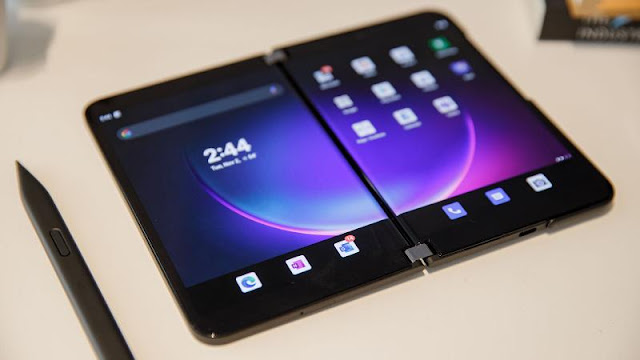
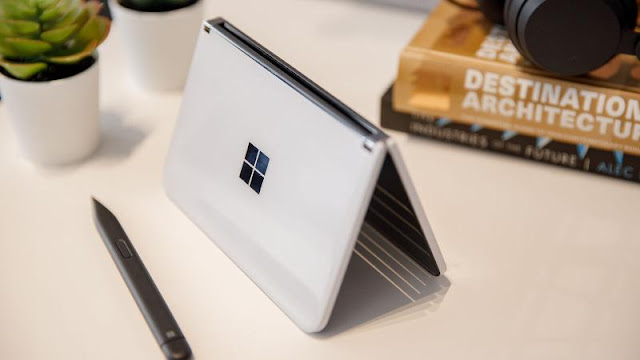
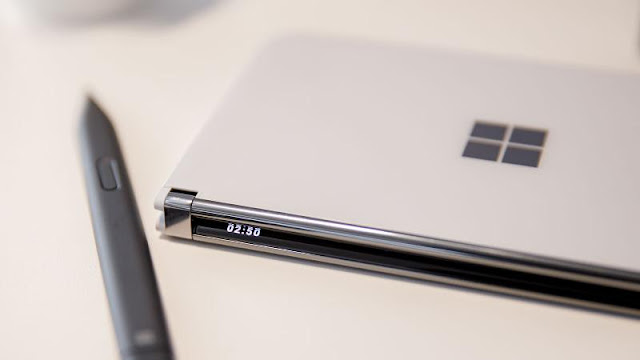



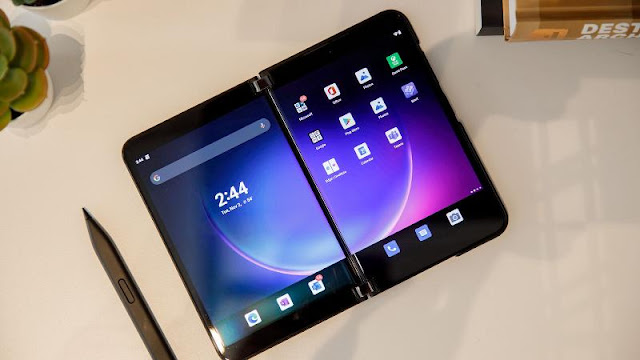

.jpg)
.jpg)
.jpg)
.jpg)
.jpg)
.jpg)
.jpg)
.jpg)
.jpg)
.jpg)
.jpg)
.jpg)
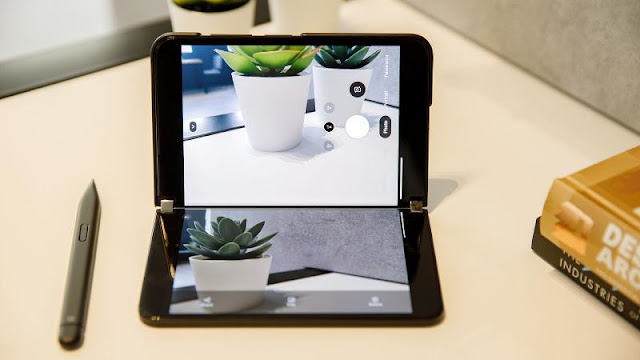


0 comments:
Post a Comment